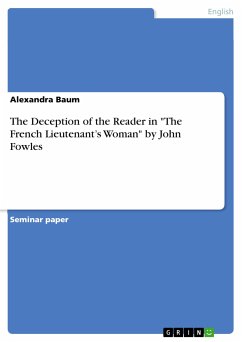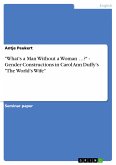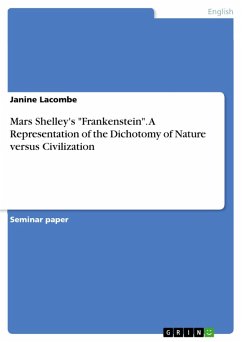Seminar paper from the year 2014 in the subject English Language and Literature Studies - Literature, grade: 2,7, University of Freiburg (Anglistik/Amerikanistik), language: English, abstract: John Fowles is a postmodern writer who was born March 31, 1926 in Leigh-on-Sea and who died in Lyme Regis, England in 2005. He was greatly inspired by the works of the French existentialists Albert Camus and Jean-Paul Sartre, which is often mirrored in his narrations. Fowles is one of the most well-known authors of Postwar British Fiction and has published his famous book (a pastiche of the Victorian novel) The French Lieutenant's Woman, which has won several awards, in 1969. Due to its popularity the book has been made into a movie starring Meryl Streep and Jeremy Irons in 1981. The novel takes place in Lyme Regis, England during the Victorian era in 1867 and is about the young gentleman Charles Smithson who, already engaged to a successful haberdasher's daughter, falls in love with Sarah Woodruff, who is disdained by the society of Lyme Regis for her alleged affair with a French lieutenant. John Fowles uses a postmodern narrator to tell a story that visibly has a very conventional Victorian framework. This narrator presents the love story of Charles and Sarah through a mixture of plot and personal comments by playing with the features of postmodern literature in order to deceive the reader and to challenge him into finding his own reality in the narration. The way the story is told shows a great interplay between the information the narrator gives to the reader and the information that is left out in order to mislead him. This technique therefore raises the question of how the reader is to understand the wholeness of John Fowles's novel when he is deceived throughout its plot. In this paper I am going to answer the question of how the reader is to understand the meaning of the book first, by giving a brief overview on Wolfgang Iser's reader-response theory and its importance in the reading experience of The French Lieutenant's Woman and second, by analyzing the different appearances of the narrator by using postmodern features like the creation of suspense, deception and illusion that Fowles used to manipulate the reader.
Dieser Download kann aus rechtlichen Gründen nur mit Rechnungsadresse in A, B, BG, CY, CZ, D, DK, EW, E, FIN, F, GR, HR, H, IRL, I, LT, L, LR, M, NL, PL, P, R, S, SLO, SK ausgeliefert werden.









